
Hear our interview with Henri Migala, aired on KNSJ radio: click here
By Henri Migala
June 4, 2020 (La Mesa) - My daughter, Rachel, a selfless and dedicated social justice advocate, told me about a demonstration in La Mesa Saturday afternoon in response to the death of George Floyd. I’ve been a responsible citizen for the past several months, self-quarantining at home in response to the COVID-19 pandemic. But like many around the world, I was outraged by the senseless death of Floyd under the knee of a Minnesota police officer.
I wanted to support the minority community by documenting this historic occasion as a photographer and as a social scientist. So I grabbed my camera and headed for the protest, never imagining the chain of events that would soon engulf the community and put La Mesa into the national news spotlight.
Along with my children, I have marched in several previous demonstrations in San Diego in support of climate change and women’s issues. I’ve also worked as an anthropologist and public health professional in multiple human and man-made disasters around the world. I am no stranger to being in intense situations, though I never covered social unrest before Saturday’s demonstration.
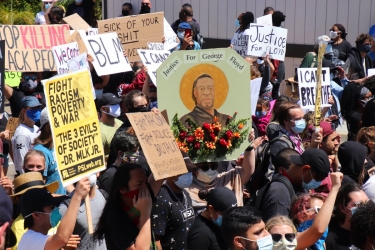 The peaceful rally and march
The peaceful rally and march
The event started around 1:30 p.m. with people gathering across the street from the police station in La Mesa. Chants of “Black Lives Matter” and “I can’t breathe” started spontaneously among the crowd and grew louder with each chant. After a few minutes, a person who seemed to be in charge got on the megaphone and told everyone that they were there to protest the death of George Floyd--and that this was to be a peaceful demonstration.
The group then started walking towards the police station, holding up their signs and continuing their chants. The leaders walked up the steps to the station’s front door. There were no police visible, nor any official from the city. The crowd, which initially adhered to social distancing, started crowding tightly together into the small patio in front of the police station. By this time, the crowd had gotten much larger and the majority of the people had to stand out in the parking lot, not able to make it onto the patio in front of the police station.
The energy of the crowd was relaxed. People wanted to share a message and that message was being shared Over the ensuing minutes, the chanting was interrupted by comments from several people, but the mic sound was not clear so I couldn’t hear their words.
 After a while, the crowd started walking away from the station toward Allison Street. There were so many marchers that they started walking into the street as they turned west on University Ave. Drivers who were blocked by the demonstrators were honking in support of the protest.
After a while, the crowd started walking away from the station toward Allison Street. There were so many marchers that they started walking into the street as they turned west on University Ave. Drivers who were blocked by the demonstrators were honking in support of the protest.
The marchers flowed down the middle of the street, some on the sidewalk, heading west. After a few blocks, the crowd turned around and headed back east on University. Drivers were sympathetic to the message of the demonstration. Even city workers who were off to the side of the street were raising their firsts in support.
The group took a left on Baltimore and a right on El Cajon Blvd. I was far behind the front of the leaders of the group, but I could see that they were stopped by the police on the far side of I-8 bridge above Spring Street.
I waited at the intersection of Baltimore and El Cajon Blvd, where there were two police cruisers. Initially the crowd was small, but over time, because the main group was stopped by the police at the far end of the bridge, protesters started coming back and confronting the police near where I was standing. The crowd was growing larger and the energy becoming more animated.
Marchers block freeway
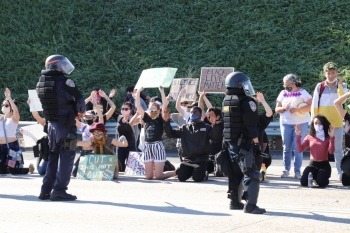 The police allowed the crowd to express their message, doing nothing to interfere. After maybe 20 minutes, the crowd at the far end of the bridge broke through the police line and continued onto Interstate 8 east. The police near me got in their cruisers and drove away, to the cheers of the crowd.
The police allowed the crowd to express their message, doing nothing to interfere. After maybe 20 minutes, the crowd at the far end of the bridge broke through the police line and continued onto Interstate 8 east. The police near me got in their cruisers and drove away, to the cheers of the crowd.
Initially, I didn’t want to go onto the freeway, so I turned away. I changed my mind and decided to walk down and see what was happening. By the time I got to the freeway, the main crowd had gone so far down I-8 East that I could no longer see the protestors. There was no traffic on I-8, in either direction.
After a while, I could see the demonstrators starting to return. I was surprised at how many people had walked down the highway; there must have been several thousand. I was still far away, but it looked like the demonstrators were stopped by the police and a discussion was going on.
The marchers continued, with the leaders or organizers trying to get marchers to walk up the El Cajon exit ramp off of I-8.
But there were some members of the demonstration group that had no desire or intention to get off the highway, and just kept marching past the exit, continuing on the main highway.
 The California Highway Patrol made a symbolic effort to stop the demonstrators, but they made no real attempt to get in their way or stop them. The CHP officers kept back-stepping as the demonstrators kept walking forward. This kept going until the officers and the demonstrators got to the El Cajon overpass. That’s where the officers and the demonstrators stopped. Most of the demonstrators started moving off the interstate and onto the side, partly because cars were somehow starting to drive on the interstate.
The California Highway Patrol made a symbolic effort to stop the demonstrators, but they made no real attempt to get in their way or stop them. The CHP officers kept back-stepping as the demonstrators kept walking forward. This kept going until the officers and the demonstrators got to the El Cajon overpass. That’s where the officers and the demonstrators stopped. Most of the demonstrators started moving off the interstate and onto the side, partly because cars were somehow starting to drive on the interstate.
The CHP managed to get all the demonstrators off the interstate, onto the grassy hill off  the highway, or onto the shoulder. Approximately 15 officers then formed a line along the interstate and the shoulder to keep the demonstrators off the freeway.
the highway, or onto the shoulder. Approximately 15 officers then formed a line along the interstate and the shoulder to keep the demonstrators off the freeway.
A couple of things started happening then. Some of the demonstrators started coming down the grassy hill, onto the shoulder of the interstate, and knelt with their hands up in the air, forming a line in front of the line of CHP officers. A few minutes later, another large group of demonstrators came from I-8 East and caught up with this smaller group. This second group changed the dynamics and energy of the interaction.
The CHP slowly stepped back away from the shoulder. But as they gave the demonstrators more room, the demonstrators filled the space, and started to move into the highway. First one lane, then another, then another--until the CHP officers were all the way across the highway and had their backs to the shoulder near the median.
Tensions mount
Some mem bers of the demonstrators were starting to get more assertive, both vocally and physically. From my perspective, I was impressed with the restraint of the CHP, several of them even pulling back one of their colleagues as he was being increasingly confronted by an overly-assertive demonstrator.
bers of the demonstrators were starting to get more assertive, both vocally and physically. From my perspective, I was impressed with the restraint of the CHP, several of them even pulling back one of their colleagues as he was being increasingly confronted by an overly-assertive demonstrator.
Once the CHP officers had gotten to the middle median, they decided to leave. The crowd cheered, but the officers leaving denied the demonstrators their audience, and defused the energy. The CHP members walked east on I-8, followed by the crowd.
About 300 yards further east, there was a solid line of officers across both direction of I-8. This was the next stand-off between demonstrators and the police. But although a few members of the demonstrators were engaging the police, most of the interaction was uneventful. This lasted for about 30 minutes, until the demonstrators slowly started pulling away.
I then started heading back to the La Mesa Police station. I was walking with another reporter who received a call from his colleague saying that the police had started using tear gas at the station, so we both headed there.
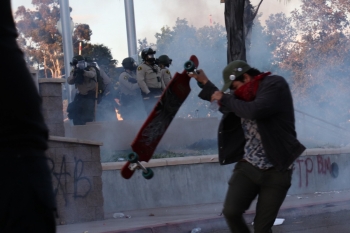 Police station stand-off: demonstration escalates
Police station stand-off: demonstration escalates
By the time I got to the police station, the stand-off had already begun between demonstrators La Mesa Police and officers in what appeared to be San Diego Sheriff uniforms. Officers were standing in front of the station, on a balcony above, and along the walls.
Tear gas  in the air made my eyes burn. This was my first exposure to tear gas.
in the air made my eyes burn. This was my first exposure to tear gas.
Media photographer hit by pepper spray
I worked my way to the south side of the police station, across the street near the post office to distance myself from the crowd of protesters being targeted.
I was wearing a bright yellow safety vest with my “MEDIA” badge on the front. I stood alone, away from any of the protesters, so that I wouldn’t be mistaken for one of them. But despite standing there, alone, for about 20 minutes, I was shot with a pepper spray paint ball in the leg.
The situation was tense, but not frightening at this point. The police had taken a stand on the patio, with people dispersed along the sides of the building. They had shooters on the upper floors – not with guns, but with pepper spray paint ball guns and rubber bullet shotguns.
Over the next hour, the crowd would slowly move closer to the police station. The police threw canisters of tear gas and “flash-bang grenades”, shot pepper spray paint balls and rubber bullets at the protesters, until the crowd moved back. This ebb and flow continued throughout the afternoon. On occasion, a rock or water bottle would be thrown from somewhere in the crowd towards the police.

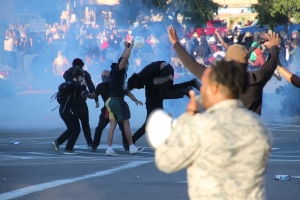
My back started hurting so I decided to sit on the curb. I had been there, just across the street from the station for about an hour. I was sitting there when I got hit by several pepper spray paint balls. They hit me in such rapid succession that I really have no idea how many hit me. But one of the balls exploded and the powder blew up into my nose and eyes. I instantly became incapacitated, not able to see or breathe.
Thankfully, a group of young Muslim girls, wearing their Hijabs, helped me up and pulled me away. They held my camera and my glasses, as they poured water on my eyes in an effort to try to flush the irritants away.
I returned to my place to keep taking pictures.
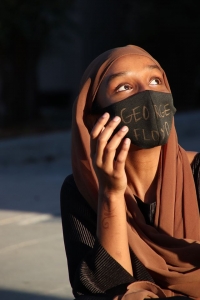

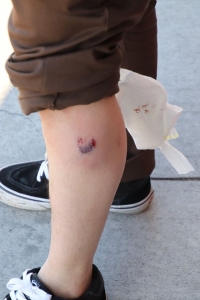 Photos, left: Two others hit by projectiles include a man struck in his upper chest and another man who said he was a journalist, struck in the leg.
Photos, left: Two others hit by projectiles include a man struck in his upper chest and another man who said he was a journalist, struck in the leg.
The final push
A Sheriff’s helicopter circling overhead repeatedly announced that un unlawful assembly had been declared. The crowd was ordered to disperse or be arrested, yet I did not observe any arrests made.
The crowd continued to remain generally peaceful, chanting “Black Lives Matter” and other slogans of the movement, though a few individuals shouted vulgar insults at police.
At 7:59, a woman protester calmly approached the police and offered them an American flag, which was accepted by an officer.
By 8;03 p.m., however, the police launched their final push to repel and disperse the protesters, with no effort to arrest anyone for civil disobedience after the unlawful assembly was declared.
Shortly before dark, many canisters of tear gas were thrown from the station, and many dozens of rubber bullets and probably hundreds of pepper spray paint balls were shot from the station in a shock and awe display to coincide with all the police rushing from the station.
Seeing all of this, the crowd dispersed and ran in all different directions. Neither the protesters nor I knew where the police were going or what they were planning. I didn’t know if they were going to charge the crowd or attack them. But they came out in force and created a perimeter around the station. That’s when I thought it would be prudent for me to go home.
I did not witness the now-infamous incident in which a woman was struck in the head by a beanbag and seriously injured around 7:30 p.m., nor the acts of arson, vandalism and looting that occurred later that night.
I was saddened to learn that a grandmother was hospitalized with a serious injury from a beanbag fired by police. I was also disheartened to learn that some individuals, perhaps not even part of the original protest against police violence, later committed acts of terror against La Mesa businesses and residents.
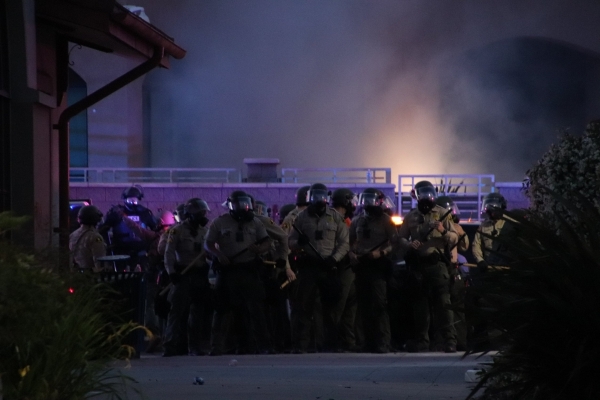
View Migala's full album with more photos at the George Floyd protest in La Mesa, California:
https://www.flickr.com/photos/69982115@N07/albums/72157714596705462/with/49976070386/
View videos by Migala of the protest:
1. Beginning of march to La Mesa Police station: https://youtu.be/98ICe4dMsvA
2. Demonstrators on LMPD patio https://youtu.be/HI6mvxha0Lk
3. Demonstrators leave LMPD patio for march https://youtu.be/y4oNAvdxxyA
4. Marchers on University Ave. https://youtu.be/njbyzGLjl2M
5. Marchers continue on University Ave. https://youtu.be/XAuJ7EBQLXM
6. Motorists honk to support marchers https://youtu.be/svMf9QJ1JQQ
7. Marchers reverse, head east on Univ. Ave. https://youtu.be/5GRv7x_VUR8
8. Crowd cheers on marchers https://youtu.be/urB-xdeNHro
9. Marchers chant, most wearing masks due to COVID-19 https://youtu.be/lsDIeYRMWrE
10. CHP cars lineup on I-8 https://youtu.be/bvE8Kh5Yu60
11. CHP officers walk back as marchers advance https://youtu.be/d9DwmL7u1X0
12. Marchers kneel on freeway in front of CHP officers https://youtu.be/lh_5SAZpQwo
13. CHP officers pull back colleague from assertive protester https://youtu.be/z8pFtdHgOxw
14. Protesters shout at police outside LMPD headquarters https://youtu.be/wPhyYW0ALYA
15. Sheriff’s helicopter announces unlawful assembly https://youtu.be/onYKyH7Q32k
16. LMPD officers fire projectiles and tear gas at protestors https://youtu.be/mKRmL6KLzRo
17. Final push: LMPD disperses demonstrators https://youtu.be/6xGUpz_TZf8
 Dr.Henri Migala is the founder of Henri Migala Photography. He has won numerous photography awards and most recently had one of his images chosen as a “Top 10” finalist in the Smithsonian Magazine Photo Contest out of 48,000 submissions. The independent photographer has previously provided video and photography for ECM ranging from bighorn sheep in the Anza-Borrego Desert to presidential candidate Elizabeth Warren’s San Diego visit .
Dr.Henri Migala is the founder of Henri Migala Photography. He has won numerous photography awards and most recently had one of his images chosen as a “Top 10” finalist in the Smithsonian Magazine Photo Contest out of 48,000 submissions. The independent photographer has previously provided video and photography for ECM ranging from bighorn sheep in the Anza-Borrego Desert to presidential candidate Elizabeth Warren’s San Diego visit .
He has lived and worked in 15 countries in global health, international development, higher education administration and humanitarian aid including disaster relief. His past positions include Director of the International House at the University of California San Diego, Executive Dean and Grants Administrator for the Grossmont-Cuyamaca Community College District, and Adjunct Faculty instructor at San Diego City College. He holds a doctor of education degree from San Diego State university, a Masters in Public Health degree from the University of North Teas, and a Master of Art degree at the University of Texas, where he studied anthropology. He is a volunteer and board member with AGuilas del Desierto, Inc., helping to save lives of lost migrants, and as a Rotary Club President, has worked with International Relief Teams. He speaks three languages (English, Spanish and French) has won many awards for his community service, and his international activities include working to eradicate polio through the World ealth Organization as well as participating in rural, border and cross-cultural health issues, , disaster relief and reconstruction. He has published numerous academic papers and written nearly $30 million in grants that have funded.
East County Magazine thanks the Facebook Journalism Project for support through its COVID-19 Local News Relief Fund Grant Program to help sustain reporting on vulnerable local populations and rural communities. Learn more at #FacebookJournalismProject.
You can donate to support our local journalism efforts during the pandemic at https://www.EastCountyMedia.org/donate.







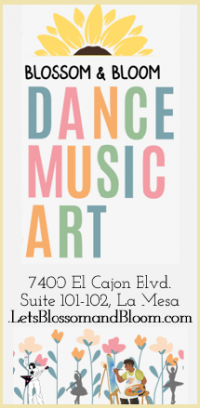








Comments
Rubber Bullets
They are not rubber. They are steel slugs with a thin rubber coating.